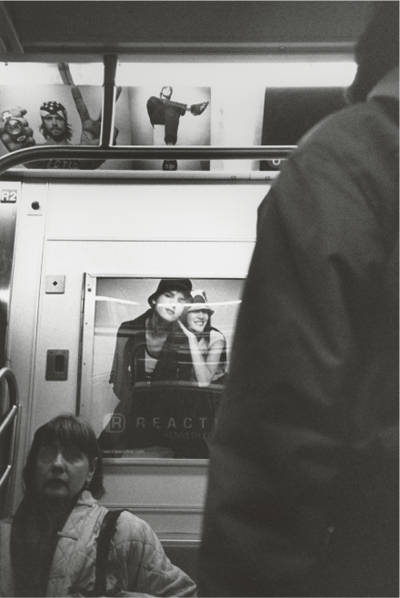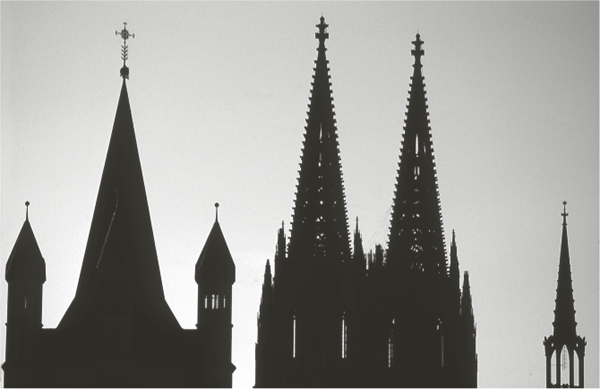4 Overcoming Clichéd Photos
After the previous brief yet important technical discussion, you are ready to focus your attention on the most essential element—the image!
If you want to improve your photographic skills, ask yourself if something is worth photographing. Think about what you really want to express in your photographs. You may be tempted to photograph clichés, such as the Cathedral in Cologne, the Eiffel Tower in Paris, and the Brooklyn Bridge in New York.
What characterizes a clichéd photo? A clichéd photograph is a shortened, simplified reproduction of a popular idea or image; it’s a poor copy, an imitation. Clichéd images do not need to be profoundly experienced by the photographer or audience, and they do not result from original thinking. Postcards are the best example of clichéd photos, generally showing popular urban attractions that are always under a clear blue sky.
cliché: A phrase, expression, or idea that has been overused to the point of losing its intended force or novelty, especially when at some time it was considered distinctively forceful or novel.
Clichéd photos quickly lose their effect. Andy Warhol’s photographs very clearly demonstrate this rapid loss with his serially reproduced Mona Lisa: The more often an image is reproduced, the more it will lose its power. This rule is indeed true in times of a pictorial deluge; as a photographer, you cannot take this seriously enough. The endless Mona Lisa reproductions have almost degraded the original painting to a cliché. As a photographer, I advise you not to add more clichéd images of the world to the almost infinite number that already exist, but liberate yourself from such clichés.
Be honest and ask yourself: When am I tempted to photograph a popular image and when is a photograph my own original image? You can liberate yourself from photographing clichés by answering the following personal questions:
• What really interests and fascinates me?
• In what facets of the exterior world do I most likely find myself?
• What are my most prominent emotions?
Photography can express your feelings because for every emotional and mental facet, you can find the corresponding facets in the external world. When you understand photography from this perspective, you automatically stop producing clichéd images.
A photo always shows two qualities:
• It shows an authentic instant in the exterior world.
• It shows the photographer’s inner world of feelings and ideas.
“Everyone walks toward the image carried within,” photographer Edouard Boubat once remarked. A painter tries to bring inner images to the canvas, while the photographer finds places in the world that resemble his internal images. The outstanding black and white photographer Robert Hausser always relied on his “gut feeling” to find places in the world that expressed his inner world.
Reduction Instead of Postcard Cliché
If you really want to photograph popular attractions, the way in which you photograph them is important. When you photograph common attractions, the reduction of form and color can make a photograph far superior to the clichéd image.
reduction: The rewriting of an expression into a simpler form. The act of reducing complexity.
For example, almost every postcard portrays Cologne Cathedral with the adjacent St. Martin’s church included in the image (figure 4–1). However, a reduced perspective of the cathedral is much less common (figure 4–2). You could photograph the cathedral with a 100 mm telephoto lens in the morning light to make the popular image, or you could take a better photograph by reducing the perspective and shooting with a 200 mm telephoto lens at dusk from the same location with the bright sky behind the cathedral. The improved photograph portrays the spires of Cologne Cathedral and adjacent St. Martin’s church silhouetted against the almost monochromatic gray sky. It is unquestionable that this image with its extreme reduction in form and tonal values is far superior to the popular image. It also shows how similar a clichéd photo and an artistic abstraction can be to each other: They both use the same perspective, but each uses a different optical system and lighting.
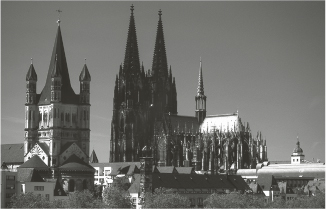
From Clichéd Photo to Personal Expression
For many years, the New York skyline with the Brooklyn Bridge and the World Trade Center was the clichéd photo of New York City (figure 4–3). To some cultures, the clichéd skyline photograph may not just symbolize New York or the United States, it may also symbolize Western capitalism. This photo is a repetition of an endlessly photographed cliché and, therefore, shows no personal contribution, in spite of its sharpness and appealing gray tones.
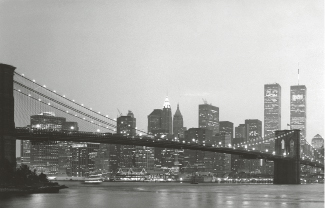
However, New York’s frequently reproduced skyline can be shown very differently (figure 4–4): A group of women practicing yoga in Midtown Manhattan, a non-typical combination that has not already been shown repeatedly. The legs of the four women project to the upper part of the image, as do the skyscrapers. The photographer composed the image so the women would not block each other when they were stretching their legs and arms toward the sky. In addition, the low perspective guarantees that the women’s legs would be higher than all the skyscrapers except for the Empire State Building. New York’s second-highest building is an extremely important element of the composition because it provides the vertical symmetrical axis. If you cover it, you will notice that the image loses it center. The clouds, roughly triangularly arranged, give the photo its mood.
The photo was taken with a 28 mm wide-angle lens that fuses foreground and background. The clouds get their drama from a medium-red filter that was used carefully so the shadows did not become too dark. The same photo could have been converted digitally using either the red or orange Photoshop filter preset to produce a very similar looking result.
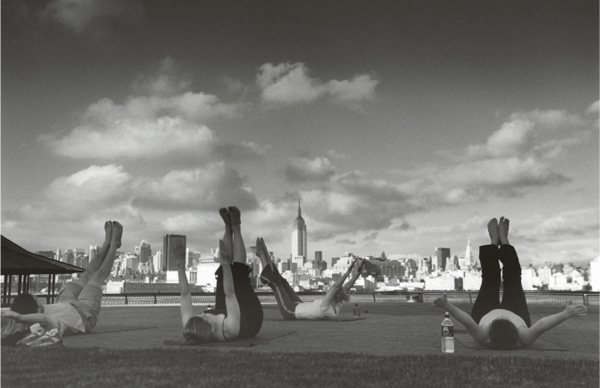
Many images, apart from the universally known skyline, are just waiting to be discovered in New York. The numerous steel bridges are ideal subjects for photographic abstracts (figure 4–5). The tiny speck in the photo is a person, embedded in this abstract shape of steel triangles. Photography can create a fusion of elements that differ greatly, for example, the fusion between the person and the bridge’s steel structure. You can almost feel the frailty of the human in contrast to the power of the heavy steel supports. A feeling of heaviness pervades the image due to the dark areas that fill the upper part of the photo. The photo might express that the person loses importance in modern architecture, that the person is just a template or a small cogwheel in a Kafkaesque gear. However, you might interpret the photograph differently. Pictorial language is free and, therefore, open to many interpretations.
The photo was taken with a 28 mm telephoto lens that fuses foreground and background.
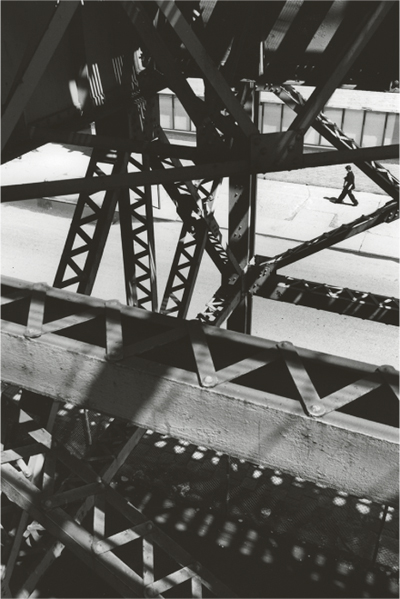
Negative feelings such as fear and anxiety can also be expressed through photography (figure 4–6). The photographer left the spotlessly clean neighborhoods of New York to find the shadow of a fire escape on a rather morbid wall of a house. The diagonal shadow of the fire escape matches the diagonal shapes of the poster with the clear imprint of “fears,” which is a picture within a picture. Trash cans on the curb and a person carrying a shopping bag suggest normalcy. The image’s atmosphere is menacing because only the lower third of the image is bright, whereas the upper part is dark and dominant. Additionally, the structure of the house wall is reminiscent of a bunker rather than a normal apartment house. It is more common for the upper part of images to be bright; therefore the inverse brightness appears menacing in an image. The atmosphere that permeates the image is more prominent than the actual place where the photo was taken. The photo was taken with an analog camera and a standard lens.
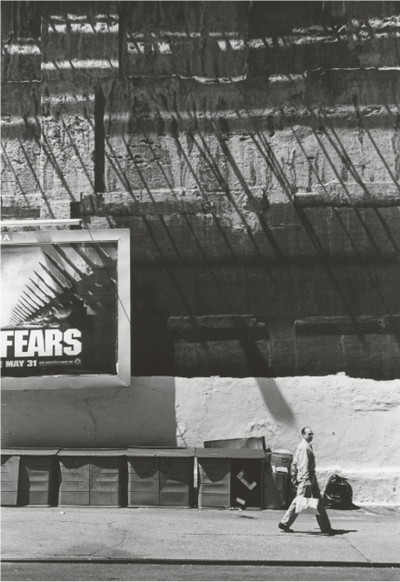
A menacing atmosphere can be created in other ways. This scene in the New York subway (figure 4–7) shows a woman placed in such a way that she seems to be in total distress: A wide-angle lens makes her appear small, and she sits in the lower-left corner and is confronted by a man whose cropped back occupies about one-third of the image; this perspective makes him look threateningly large from below. From a pictorial perspective, the woman has no escape. To her left is a railing; to her right is the large back of the man whose face is hidden from view. The neon lights emphasize the circles under her eyes and she looks pensively, almost fearfully, toward the man. Even if this scene were totally harmless in reality, the pictorial drama gives the impression that the man is threatening the woman. The advertisements behind the woman, on the other hand, give the image an ironic twist as two elegantly dressed young women snuggle close to each other. This portrayal of youth might also distress the woman in another way because (as opposed to the models) she’s no longer the youngest. In the upper-left corner, another ad shows a bearded young man with unkempt hair wearing a scarf with the American flag and carrying a large watch in his right hand and flashing a peace sign with his left. These ads contrast with the apparently charged atmosphere between the sitting woman and the standing man.
The photo was taken with an analog Nikon F4 using Fuji Neopan 400 film pushed to 800 ASA.
